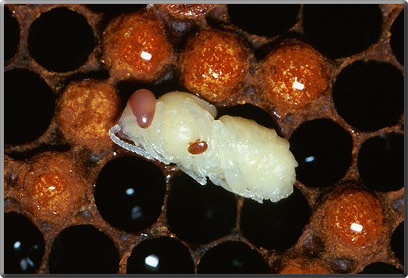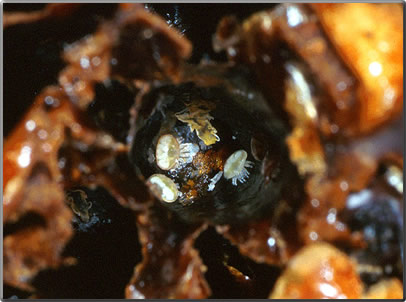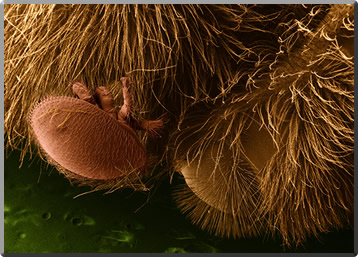Varroa
Managing varroa destructor
 A varroa mite on the body of a developing larva
A varroa mite on the body of a developing larvaPhoto by Scott Bauer
 A family of varroa mites found at the bottom of a brood cell.
A family of varroa mites found at the bottom of a brood cell.Photo by Scott Bauer.
There are many accounts for managing the varroa destructor mite which are available on the internet. See for example:
the New Zealand Ministry of Agriculture and Fisheries.
In the UK Bee Base is a valuable source for all things bee.
The booklet Varroa unter Kontrolle gives the German perspective.
In Canada the use of formic acid in the form of Mite Away Quick Strips (MAQS) has been marketed. This product was quickly registered for use in all states in the USA, and in association with BASF the German pharmaceutical giant is in the course of being brought to the European market. The product was approved for use in the U.K. in February 2013 and is now for sale in this market.
An EU Report on Varroa from 1991 can be viewed here.
And little more needs to be said here. What is particularly interesting are the accounts on how varroa is tackled world wide and the various treatments used particularly in Europe and Canada. In view of the fact that the varroa mite has become resistant to the two miticides used world wide - Apistan and Bayvarol, some of this information in the above accounts is out of date but the information on other chemical treatments remains valid.
Basically what emerges is that where varroa is present treatment (or evaluation of the situation) needs to be given (made) three times a year:
in Spring before the supers go on;
in late Summer after the supers come off; and
in mid Winter when no brood is present.
There is no overall agreement as to what treatment should be used nor as to the product which is allowed in each country. Where a strategy has evolved it is promoted by the respective National Beekeeping Association.
However, in some countries there is no overall strategy.
The Spring treatment may involve the use of formic acid or drone brood trapping;
the late Summer treatment may again use formic acid or thymol; whereas
the mid Winter treatment always uses oxalic acid.
the New Zealand Ministry of Agriculture and Fisheries.
In the UK Bee Base is a valuable source for all things bee.
The booklet Varroa unter Kontrolle gives the German perspective.
In Canada the use of formic acid in the form of Mite Away Quick Strips (MAQS) has been marketed. This product was quickly registered for use in all states in the USA, and in association with BASF the German pharmaceutical giant is in the course of being brought to the European market. The product was approved for use in the U.K. in February 2013 and is now for sale in this market.
An EU Report on Varroa from 1991 can be viewed here.
And little more needs to be said here. What is particularly interesting are the accounts on how varroa is tackled world wide and the various treatments used particularly in Europe and Canada. In view of the fact that the varroa mite has become resistant to the two miticides used world wide - Apistan and Bayvarol, some of this information in the above accounts is out of date but the information on other chemical treatments remains valid.
Basically what emerges is that where varroa is present treatment (or evaluation of the situation) needs to be given (made) three times a year:
in Spring before the supers go on;
in late Summer after the supers come off; and
in mid Winter when no brood is present.
There is no overall agreement as to what treatment should be used nor as to the product which is allowed in each country. Where a strategy has evolved it is promoted by the respective National Beekeeping Association.
However, in some countries there is no overall strategy.
The Spring treatment may involve the use of formic acid or drone brood trapping;
the late Summer treatment may again use formic acid or thymol; whereas
the mid Winter treatment always uses oxalic acid.
Varroa and Viruses
How do bees defend themselves from disease?
The high density populations and conditions within the bee colony (enclosed, moist, dark, sometimes poorly ventilated) are ideal for the outbreak and spread of disease. Fortunately, because bees are constantly expose to pathogenic micro-organisms, they have evolved strategies to resist infection. The cuticle of bees acts as a barrier to penetration, and immune system based defence can prevent infection of many minor pathogens. However, the recent completion of the honey bee genome sequence has shown that they have only about a third of the number of known immunologically related genes when compared to flies or mosquitoes, suggesting that bees rely less on individual immunity than most insects.
The high density populations and conditions within the bee colony (enclosed, moist, dark, sometimes poorly ventilated) are ideal for the outbreak and spread of disease. Fortunately, because bees are constantly expose to pathogenic micro-organisms, they have evolved strategies to resist infection. The cuticle of bees acts as a barrier to penetration, and immune system based defence can prevent infection of many minor pathogens. However, the recent completion of the honey bee genome sequence has shown that they have only about a third of the number of known immunologically related genes when compared to flies or mosquitoes, suggesting that bees rely less on individual immunity than most insects.

Low temperature scanning electron micrograph (LTSEM) of Varroa destructor on a honey bee host
How does the varroa mite affect bees?
The effect comes about in two ways:
either when the varroa mite is being carried on an adult bee, it finds the weak spot and crawls under the overlapping abdominal plates where it feeds on hemolymph (bee blood). The bee now becomes susceptible to viruses;
or as a result of the mother mite feeding her offspring on bee larvae or pupae in the brood cell. This then affects the development of the pupa into an adult; deformed wing virus (DWV) can result.
The effect comes about in two ways:
either when the varroa mite is being carried on an adult bee, it finds the weak spot and crawls under the overlapping abdominal plates where it feeds on hemolymph (bee blood). The bee now becomes susceptible to viruses;
or as a result of the mother mite feeding her offspring on bee larvae or pupae in the brood cell. This then affects the development of the pupa into an adult; deformed wing virus (DWV) can result.
My own experience with varroa was initially rather limited. I suppose like most hobby beekeepers I took the easy way out and followed the local practice. Each November I treated each colony with the approved miticide (Bayvarol) and hoped for the best. However, some years ago my eyes were opened in two ways:
Firstly, on the chance meeting with a neighbouring beekeeper she told me that her colonies that summer had been devastated by varroa, and stated that "Bayvarol was useless". The fact that the varroa mite had become resistant to Bayvarol has been well reported but I did not think that this was apparent so close to home.
Secondly, in two of my colonies I saw quite a number of bees with deformed wings on the alighting boards. In fact in one colony the defective bees were being forcibly ejected from the hive by worker bees. Whilst I congratulated myself that my bees were showing a strong hygienic behaviour, I was forced to address the varroa problem and in the future resolved to take a more pro-active approach as described in the following pages.
Firstly, on the chance meeting with a neighbouring beekeeper she told me that her colonies that summer had been devastated by varroa, and stated that "Bayvarol was useless". The fact that the varroa mite had become resistant to Bayvarol has been well reported but I did not think that this was apparent so close to home.
Secondly, in two of my colonies I saw quite a number of bees with deformed wings on the alighting boards. In fact in one colony the defective bees were being forcibly ejected from the hive by worker bees. Whilst I congratulated myself that my bees were showing a strong hygienic behaviour, I was forced to address the varroa problem and in the future resolved to take a more pro-active approach as described in the following pages.